Last updated on April 18th, 2022
25 Interesting facts about Brooklyn Bridge include the urban myth about selling the Brooklyn Bridge to rubes in New York, fun facts and information about the bridge’s colorful history in the world’s most famous city. Some facts might be hard to believe, but they are nonetheless true.
25 Interesting Facts about Brooklyn Bridge
1. The basis for the meme of selling the Brooklyn Bridge to some out-of-town rube has its basis in fact. George C. Parker, a con man who lived from 1860 to 1936, was known for swindling people by selling the Brooklyn Bridge and other property he didn’t own. Surprisingly, people fell for the scam, and Parker sold the Brooklyn Bridge many times over the years. Local police were called to remove several “owners” who were attempting to build toll booths on the busy bridge.[1]
2. A bomb shelter was discovered beneath the Brooklyn Bridge as recently as 2006. The supplies uncovered include 352,000 packs of crackers, water drums, blankets and medical supplies. The cache was discovered during a structural inspection, and it probably dates back to the Cold War.[2]
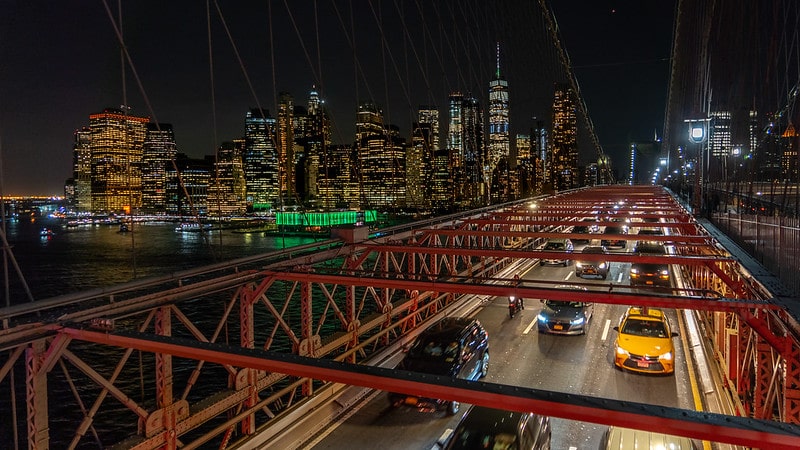
3. Famous circus entrepreneur P.T. Barnum once marched 21 elephants across the Brooklyn Bridge. On May 17, 1884, he marched his elephants across the bridge as a publicity stunt for his circus, which was operating at a showground at the intersection of Fulton and Tompkins Avenues. He wanted to prove the bridge was safe enough for elephants to cross. It doesn’t compare with Hannibal crossing the Alps, but it’s an interesting footnote.[2]
4. The Topps Company decided to clean out its warehouse in 1960. The company threw out boxes of baseball trading cards, dumping them in the water near the Brooklyn Bridge. The cards, poorly selling at the time, included a Mickey Mantle that currently sold for $500,000 at auction.[2]
5. Brooklyn was once a city in its own right, instead of being a borough of New York. The city decided to merge with New York, but it was unpopular at the time. Many residents call the merger “the great mistake of 1898.”[2]
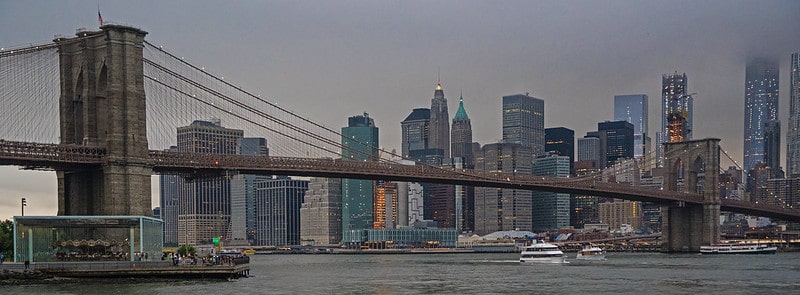
6. The bridge’s construction initially took some bribery to get off the ground. An engineer named John Augustus Roebling conceived of the idea of a bridge across the East River to make an easier commute for the working class to travel between Brooklyn and Manhattan. The tactics he used to get the project built included making a big payoff to William “Boss” Tweed to the tune of $65,000 in bribes for Tweed’s political cronies.[3]
7. Although the bridge was Roebling’s project, he paid a high price because he didn’t live long enough to see his dream come true. In 1869, Roebling crushed his foot in an accident with a ferry, and he later died of tetanus contracted from the injury.[3]
8. Roebling’s son, Washington Augustus Roebling, took over the project, but his luck wasn’t much better than his father’s. As chief engineer of the project, Washington Roebling worked closely with workers in sealed chambers called caissons, which kept areas dry for digging. Unfortunately, breathing required compressed air, and workers often developed “caisson disease,” which is now known as the bends. Roebling developed a bad case of decompression sickness and was confined to his bed.[3]
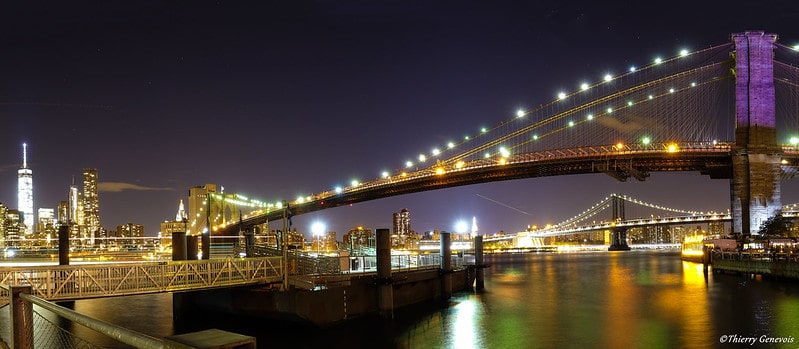
9. The name of the Brooklyn Bridge seems to be a no-brainer, but the bridge operated under several names. It was referred to as the Great East River Bridge and The Great East River Suspension Bridge. At its dedication in 1883, it was christened as the New York and Brooklyn Bridge. Due to the demands of Brooklyn residents, the name was shortened to the Brooklyn Bridge in 1915.[3]
10. You’ve probably heard about canaries testing the oxygen levels in mines, but imagine for a moment using a rooster to test the bridge. In fact, a rooster made the first trip across the bridge. Washington Roebling’s wife Emily took over many of the details of the project, relaying his husband’s orders. She was the first to cross the bridge in a carriage, and she held a rooster on her lap for good luck.[3]
11. Emily Roebling became an engineer in her own right as she learned the ropes from relaying her husband’s orders. She became the de facto chief engineer of the project. Today, Emily Warren Roebling is considered a feminist icon and a major driving factor in the multiyear project’s successful completion. Emily went to school to earn a law degree in later years and wrote early popular articles about gender equality.[3]
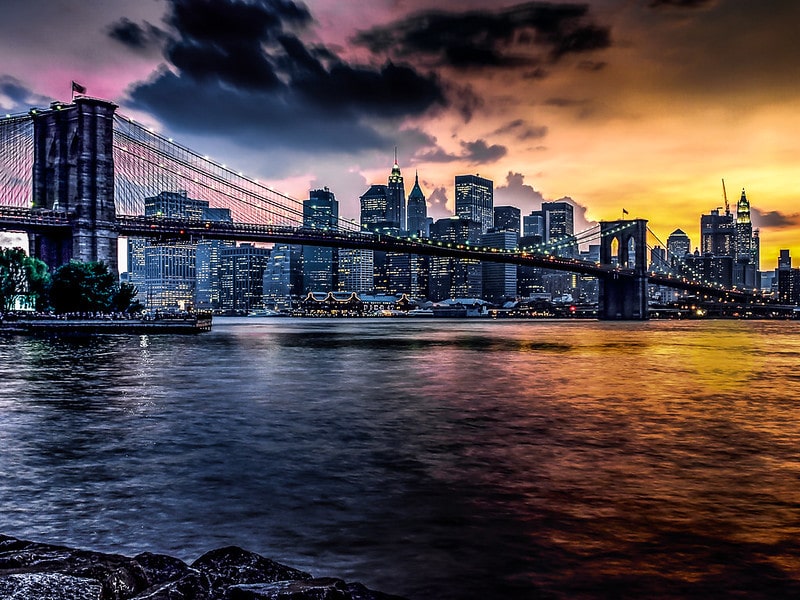
13. The bridge opened on May 24, 1883 and received leisurely use for the first five days. On May 30th, however, things changed. Some say that a woman tripped; others claim a rumor of an impending collapse stated the stampede. The resulting panic caused 12 deaths and 36 or more serious injuries.[3]
14. Engineers decided to build vaults under the bridge for storing wine at a continuous cool temperature. The granite vaults, cooled by the East River, were 50 feet tall. A. Smith & Company paid $500 per month to rent the vaults on the Brooklyn side while Luyties Brothers, a liquor distributor, paid an astronomical $5,000 per month for the Manhattan-side vaults.[3]
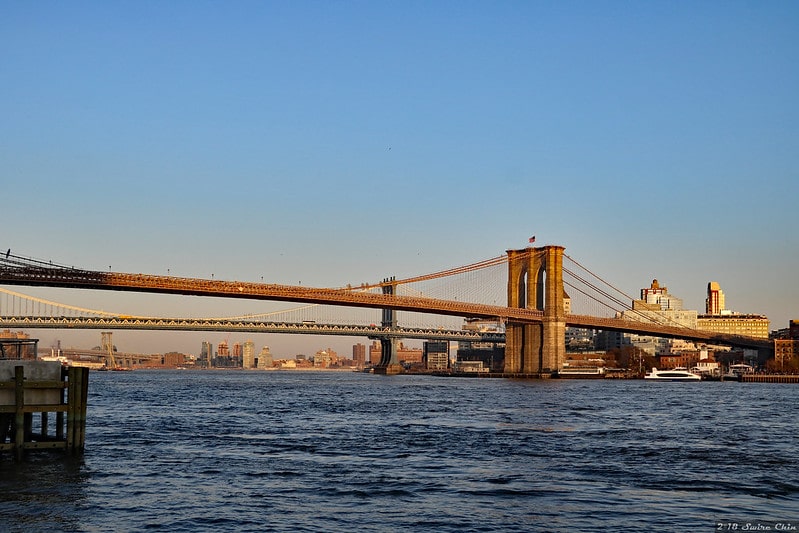
15. One of the contractors, J. Lloyd Haigh, tried to substitute sub-par wires for cables supporting the bridge. The wire’s quality went unnoticed until after it had been used in parts of the bridge. Embarrassed by the swindle, the project increased security measures and increased the wire beyond what was necessary to keep the public from learning the truth. Haigh wasn’t prosecuted for this crime, but was convicted on a count of forgery in an unrelated case later.[3]
16. The Brooklyn Bridge was the longest suspension bridge in the world for 20 years, but records fell rapidly during the Industrial Revolution. Reaching 1,595 feet with its main span, the total length of the bridge was 5,985 feet. It was surpassed by its twin across the East River, the Williamsburg Bridge, which measured 7,308 feet.[3]
17. The Manhattan side of the bridge displays a bronze plaque that commemorates the site as the location of the first presidential mansion. Yes, George Washington really slept here during the first 10 months of his fledgling presidency.[3]

18. The bridge took 14 years to build, and the project used 600 workers. The cost was $15 million, and the bridge used 6,740 tons of material. The bridge is supported using four cables that are 3,570 feet long and 15.5 inches thick.[4]
19. The Brooklyn Bridge handles more traffic than the original engineers envisioned, carrying more than 100,000 cars and 4,000 pedestrians each day. That’s quite an increase from the 21 elephants that P.T. Barnum used to showcase the bridge’s stability.[4]
20. Peregrine falcons make their home in the bridge’s penthouses located in the two towers. Visitors to the bridge can often view the birds coming and going, just a few more harried commuters that avoid the worst traffic jams by flying.[4]

21. The towers of the Brooklyn Bridge are built of granite, limestone and Rosendale cement, and they rise 276 feet above the water.[5]
22. The Brooklyn Bridge was designated a National Historic Landmark in 1964. It has held iconic status since its opening, and it was named a National Historic Civil Engineering Landmark in 1972.[5]
23. The Brooklyn Bridge remains one of the most important landmarks of New York City, and it’s a major tourist attraction. The opening of the bridge helped to transform Brooklyn from a rural region to one of the busiest urban neighborhoods in the world. Visitors get spectacular views of the New York skyline, the Statue of Liberty and the East River, and strolling along can be one of the most romantic events in all of New York.[6]

24. Many have died or committed suicide by leaping from the bridge into the East River. Robert E. Odlum became the first person to leap into the river. He was a swimming instructor who thought he could survive the dive, but he didn’t. Many jumpers have since survived their leaps, including one man trying to impress his girlfriend and one who wore a pair of canvas wings.[6]
25. The Brooklyn Bridge inspires art in various media including paintings by Andy Warhol and Georgia O’Keeffe, photographs by Walker Evans, plays, novels, documentaries, poems by Jack Kerouac and musicians like Simon and Garfunkel. The bridge is often filmed to set the scene for movies and sitcoms that include Annie Hall, I Am Legend, Once Upon a Time In America, It Happened in Brooklyn, Gangs of New York, Godzilla, The Avengers and The Dark Knight Rises.[6]
